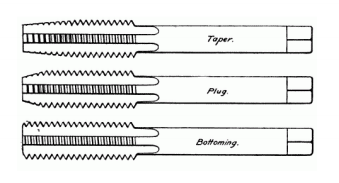Hole Tapping Tips, Where to Begin
Last updated: October 20, 2023


This is a follow-on to my "Already Done Some Hole Tapping" article. After I submitted that one to
The Metalsmith, I posted it to alt.crafts.blacksmithing, and received this question:
"What, if anything else, would you recommend for someone who has never tapped a hole?"
Here's my response:
-Do some practice tapping of holes in mild steel BEFORE you need to do it on an actual project. I know this will probably
sound terrible, but you might even buy a few CHEAP taps in sizes like 8-32, 1/4-20 and 3/8-16 for "testing".
-Get a chart for drill sizes to use for the various taps. There are many of these charts on the internet. Just Google:
"tap size chart".
-Drill some correct tap size holes (through-holes, for starters), chamfer them, and then try tapping them using the info
in the previous article.
The idea here is that if you break a tap, you are only out a buck or two and the broken off tap is not
stuck in a project.
-You want to start to get a "feel" for cutting versus binding. You will notice, particularly with the smaller taps, that
they can actually take SOME twisting before they break.
-Try tapping some holes without lubrication (after you have done it properly WITH lubrication) a couple of times.
If you tap two or three holes with each size and don't break any taps off, then drill some more tap holes, but make them
several thousandths too small.
Note the differences in the amount of force it takes to get the tap to cut.
Obviously, "several thousandths too small" on the holes for the 8-32 tap will have a lot more negative affect than the same
"several thousandths" on the holes for the 3/8-16 tap.
You may want to "test to destruction", or you may want to chicken out.
-By this time, you may have to get a few more cheap taps.
-After all that, try the same thing in aluminum, say T6061. Use Kerosene as a lubricant. Note the gummy-ness in the chips.
Note that you can get the tap stuck more easily. Do the same thing with some scrap brass. Several samples if
possible, because the various brass alloys differ a lot in machine-ability.
Keep doing this until all the cheap taps are either stuck or broken off. Then you will be a lot wiser and the
cheap taps won't be around to bite you in the behind some other day.
-Once you get to this point, start asking questions about tapping in tool steels and stainless steels.